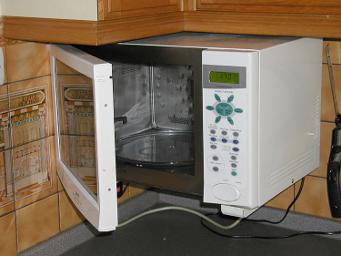Making Tea Using a Microwave
Wikipedia: Microwave_ovenLast Updated: Oct. 31, 2013

A microwave oven can be used to conveniently heat water for tea, but is often not the best method, for a variety of reasons.
However, sometimes, such as in a workplace, a microwave is the only available option for heating water. If you do choose to brew tea using a microwave, a few tips can make your experience safer and more enjoyable:
Tips for making tea using a microwave:
- Use the microwave only to heat the water. - Do not place your tea bag or the loose-leaf tea in the water before placing the water in the microwave; rather, heat the water up first and then pour it over the tea, or place the tea in it. Metal staples or metal in tea infusers can cause dangerous electrical arcs! Even if there is no metal, placing the tea leaves in the water before it is heated is not a good method as it will start the tea steeping while the water is still cool, and also will give you little control over steeping time and temperature.
- Be cautious about superheating water. Although relatively uncommon, it is possible to superheat water (heat it above the boiling point) using a microwave. Superheated water can be dangerous because it can boil instantly in a process called "erupting" (it looks like an explosion) when it contacts an object (like a tea bag), and can cause burns. This is most likely to happen when using a glass mug and very pure water, such as distilled water, so that there are no surfaces for bubbles to condense on. Using tap water can prevent superheating. The video below demonstrates superheating:
- Get to know your particular microwave. Different microwaves have different strengths; on the highest setting, a powerful microwave might boil a cup of water in a minute, whereas a weaker one might take three minutes to bring the same cup to boiling. Both to help you reach your ideal brewing temperature, and avoid superheating water, get to know each particular microwave.
- Use microwave-safe vessels. When in doubt, only use a mug marked as microwave safe. A microwave-safe vessel is one that does not cause electrical arcs, and does not absorb any of the microwaves as heat. If you use a vessel that is not microwave safe, uneven heating, or heating faster than the water itself can cause it to crack, shatter, melt, burn, or catch fire. In some cases, electrical arcs and explosions can occur. Be particularly cautious of metal trim on ceramics, as metal can cause arcing.
Microwaves are less energy efficient:
Both in the interest of sustainability, and keeping your electric bill down, it is worth thinking about the amount of energy used by different methods of heating water for tea. Scientific American published an interesting piece comparing the efficiency of stove vs. microwave for a cup of tea. They cite an analysis by Home Energy Magazine, which concluded that microwaves use 25% more than electric stoves. Gas stoves are even more efficient. So, if you are concerned about saving energy or keeping your electric bill down, use the stovetop to heat water for tea.Further Resources:
- Microwave Ovens and Food Safety - A resource on the USDA website which has a wealth of information about microwave safety, including information on preventing arcing and erupting from superheating.

